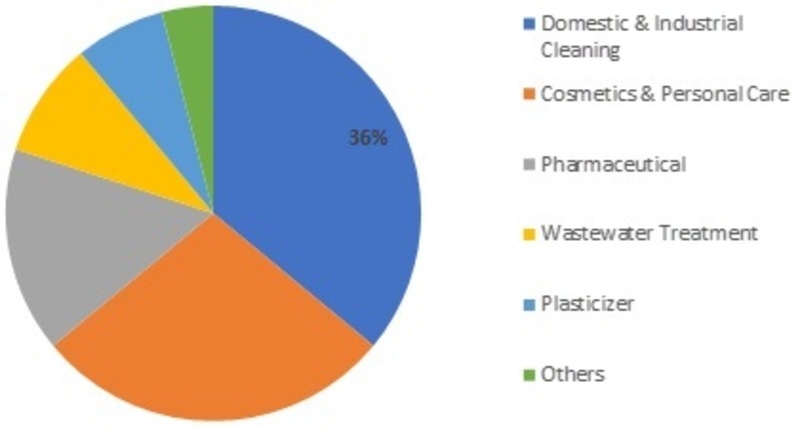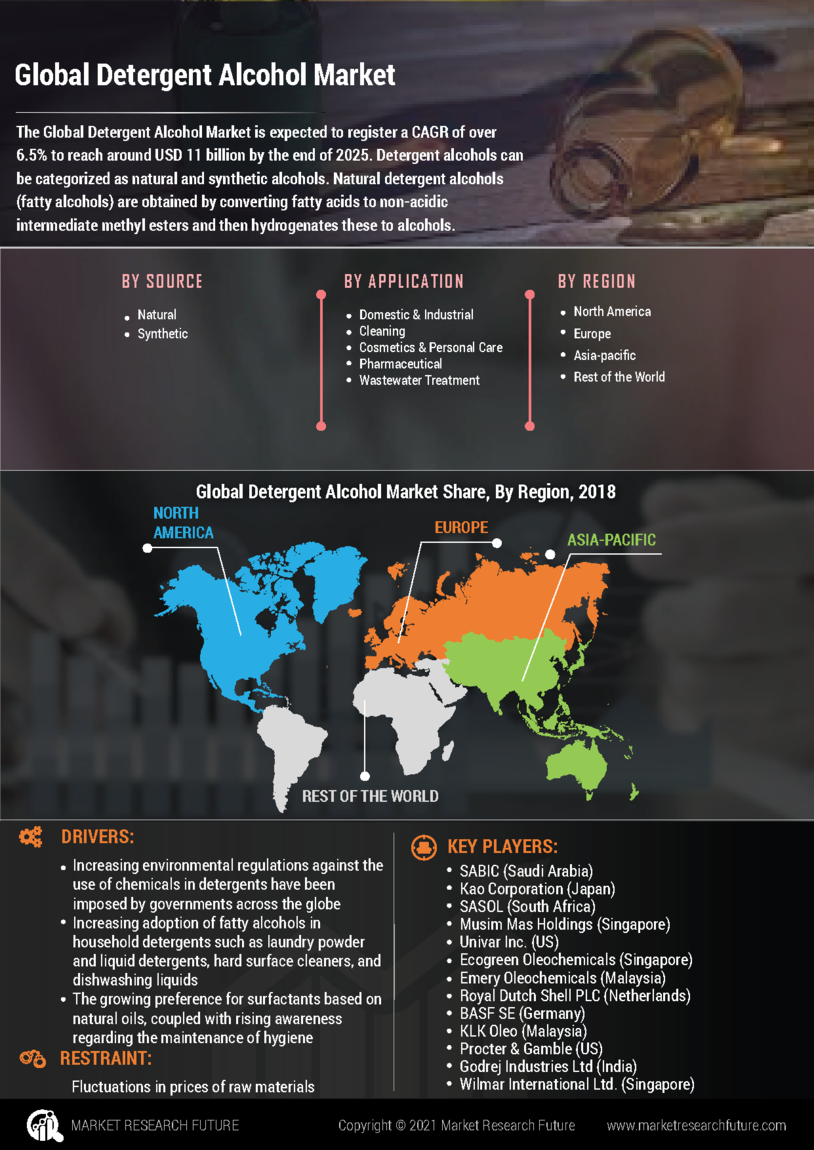Detergent Alcohol Market Overview
The detergent alcohol market is expected to register a CAGR of over 6.30% to reach around USD 15 billion by the end of 2032.
Detergent alcohols can be categorized as natural and synthetic alcohols. Natural detergent alcohols (fatty alcohols) are obtained by converting fatty acids to non-acidic intermediate methyl esters and then hydrogenates these to alcohols. Artificial detergent alcohols are derived from petrochemical sources.
Detergent alcohols find use in numerous applications such as domestic & industrial cleaning, personal care, pharmaceutical, wastewater treatment chemicals, plasticizer, and others. Among the applications above, domestic & industrial cleaning is the significant revenue-generating an application for the detergent alcohols market due to their increasing use as non-ionic surfactants in detergents.
Increasing environmental regulations against the use of chemicals in detergents have been imposed by governments across the globe, owing to which detergent manufacturers are increasingly using natural oils over chemicals, which is likely to fuel the demand for natural detergent alcohols.
The global demand for detergent alcohols is mainly driven by increasing adoption of fatty alcohols in household detergents such as laundry powder and liquid detergents, hard surface cleaners, and dishwashing liquids. The growing preference for surfactants based on natural oils, coupled with rising awareness regarding the maintenance of hygiene, is projected to drive market growth during the forecast period.
Natural detergent alcohols are being widely used in the cosmetics and personal care industry as emollients and thickening and cleansing agents as they help improve the viscosity of lotions and creams. The growing cosmetics and personal care industry in Asia-Pacific, with a surge in demand for premium skin and hair care products, child beauty care products, and color cosmetics, rising per capita disposable incomes, and changing lifestyles are expected to boost the growth of the global detergent alcohol market.
Growing preference for liquid table detergents and concentrated liquid detergents over powder detergents in China as the former offer strong cleaning capability and promote healthy skin is likely to create lucrative opportunities for the players operating in the global detergent alcohols market. However, fluctuations in prices of raw materials are likely to affect market growth.
Key Players
List of the key companies operating in the global detergent alcohol market are
SABIC (Saudi Arabia), Kao Corporation (Japan), SASOL (South Africa), Musim Mas Holdings (Singapore), Univar Inc. (US), Ecogreen Oleochemicals (Singapore), Emery Oleochemicals (Malaysia), Royal Dutch Shell PLC (Netherlands), BASF SE (Germany), KLK Oleo (Malaysia), Procter & Gamble (US), Godrej Industries Ltd (India), and Wilmar International Ltd. (Singapore) among others.
Global Detergent Alcohol Market Share, by Application, 2018 (%) 
Source: MRFR Analysis
Regional Analysis
The market in Asia-Pacific accounted for the largest share of the global detergent alcohol market in 2018 and is expected to witness significant growth during the review period. The growing industrial base in the developing countries has resulted in increased demand for detergents and thus, detergent alcohols. Additionally, expanding the plastic industry on account of rising demand for plastics in numerous end-use industries such as healthcare, packaging, and automotive, among others.
Europe is projected to be the prominent market for detergent alcohol on account of the increasing regulations on the use of chemicals in the manufacturing of detergents. For instance, the International Association for Soaps, Detergents, and Maintenance Products established by the European Commission has set limitations regarding the extent to which phosphates and other phosphorus compounds can be used in laundry detergents and automatic dishwasher detergents.
The market in North America is expected to witness significant growth during the review period. The prevalence of strong cosmetics and personal care industry, coupled with a surge in demand for organic cosmetics products, is supporting the market growth in the region.
The Latin American market is expected to exhibit considerable growth concerning the growing industrial base coupled with rising per capita disposable income of the consumers. The Middle East & Africa is likely to witness moderate growth during the review period with growing end-use industries such as cosmetics & personal care, plastics, and surfactant.
Segmentation
The global detergent alcohol market has been segmented based on source, application, and region.
Based on the source, the global market has been segregated into natural & synthetic.
Based on application, the global market has been categorized as domestic & industrial cleaning, cosmetics & personal care, pharmaceutical, wastewater treatment, plasticizer, and others.
The global market, by region, has been segregated into North America, Europe, Asia-Pacific, Latin America, and the Middle East & Africa.
Recent Development
September 2021- ASU researchers published research on plastic pollution from detergent pods that discovered the pods not as earth-conscious as some brands boast, increasing environmental concerns and how corporations define environment-friendly. Laundry or dish detergent pods, digitally called forbidden fruits, are wrapped in a water-soluble plastic called polyvinyl alcohol (PVA). Started by an investigation and investment from cleaning solution brand, Blueland, the team of researchers from ASU working with non-profit Plastic Oceans International researched the environmental impacts of PVA from detergent pods. AS PER THE RESEARCHERS ' STATEMENT, these PVA pods, usually marketed as biodegradable, do not have adequate research to back their environment-friendly claims. Their research focuses on holding advertisers responsible and saying things accurately, Rolsky, the director of science for Plastic Oceans, said.
May 2021- Smol, a laundry detergent DTC startup, has managed to raise USD34million (£24.1m) in a funding round. The business, established in 2018 by Paula Quazi and Nick Green, offers laundry capsules, fabric conditioners, dishwasher tablets, and surface sprays direct to customers' doors through a subscription service. The funding of USD34 million comes as the firm doubles the sales this year.
Intended Audience
- Detergent alcohol manufacturers
- Traders and distributors of detergent alcohol
- Research and development institutes
- Nationalized laboratories
| Attribute/Metric |
Details |
| Market Size |
USD 15 billion 2032 |
| CAGR |
6.30% 2032 |
| Base Year |
2023 |
| Forecast Period |
2024 to 2032 |
| Historical Data |
2019 & 2020 |
| Forecast Units |
Value (USD Billion) |
| Report Coverage |
Revenue Forecast, Competitive Landscape, Growth Factors, and Trends |
| Segments Covered |
Source, Application |
| Geographies Covered |
North America, Europe, Asia-Pacific, and Rest of the World (RoW) |
| Key Vendors |
SABIC (Saudi Arabia), Kao Corporation (Japan), SASOL (South Africa), Musim Mas Holdings (Singapore), Univar Inc. (US), Ecogreen Oleochemicals (Singapore), Emery Oleochemicals (Malaysia), Royal Dutch Shell PLC (Netherlands), BASF SE (Germany), KLK Oleo (Malaysia), Procter & Gamble (US), Godrej Industries Ltd (India), and Wilmar International Ltd. (Singapore) among others. |
| Key Market Opportunities |
· Growing preference for liquid table detergents · Concentrated liquid detergents · Rising per capita disposable incomes · Changing lifestyles |
| Key Market Drivers |
· Increasing adoption of fatty alcohols · The growing preference for surfactants based on natural oils · Rising awareness regarding the maintenance of hygiene |
Detergent Alcohol Market Highlights:
Frequently Asked Questions (FAQ) :
The detergent alcohol market is projected to grow at a 6.30% CAGR between 2024-2032.
The detergent alcohol market is predicted to touch USD 15 billion by 2032.
The APAC region is expected to have a major share in the detergent alcohol market.
Fluctuations in raw material prices may limit market growth.
Growing cosmetics & personal care industry and preference for liquid table detergents are boosting market growth.















